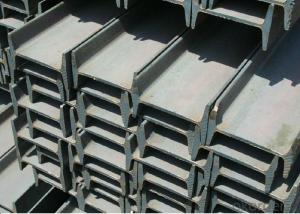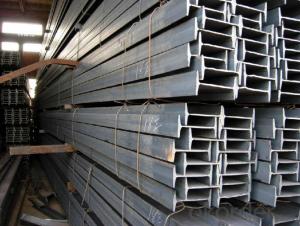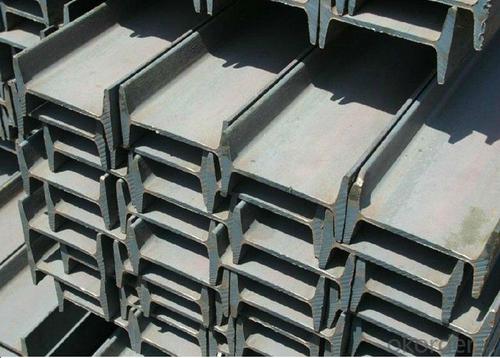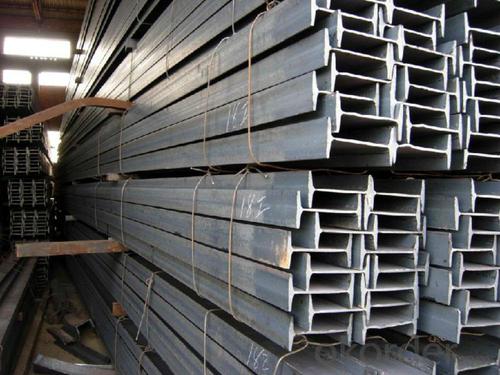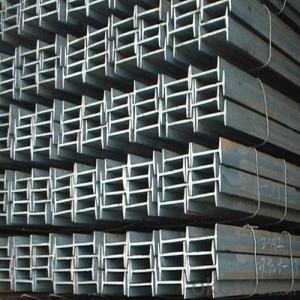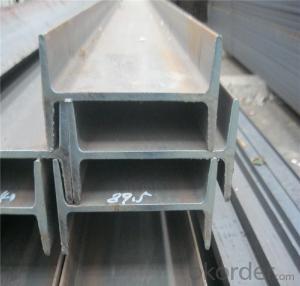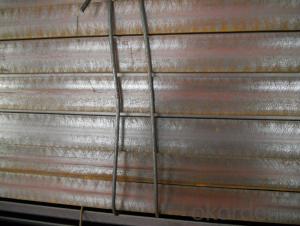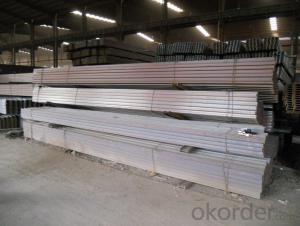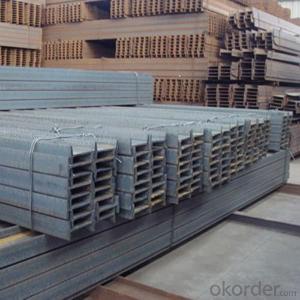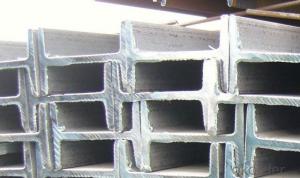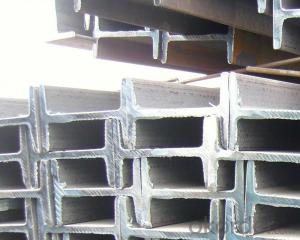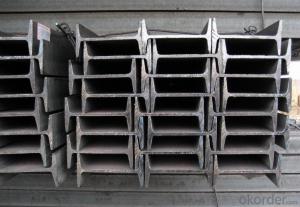Hot Rolled Steel I-Beams with best price
- Loading Port:
- Tianjin
- Payment Terms:
- TT OR LC
- Min Order Qty:
- 25 m.t
- Supply Capability:
- 10000 m.t/month
OKorder Service Pledge
OKorder Financial Service
You Might Also Like
Specification
OKorder is offering high quality Hot Rolled Steel I-Beams at great prices with worldwide shipping. Our supplier is a world-class manufacturer of steel, with our products utilized the world over. OKorder annually supplies products to European, North American and Asian markets. We provide quotations within 24 hours of receiving an inquiry and guarantee competitive prices.
Product Applications:
IPE/IPEAA Beam Steel are widely used in various construction structures, bridges, autos, brackets, mechanisms and so on.
Product Advantages:
OKorder's Steel I-Beams are durable, strong, and resist corrosion.
Main Product Features:
· Premium quality
· Prompt delivery & seaworthy packing (30 days after receiving deposit)
· Corrosion resistance
· Can be recycled and reused
· Mill test certification
· Professional Service
· Competitive pricing
Product Specifications:
1. Product name: IPE/IPEAA Beam Steel
2. Standard: EN10025, GB Standard, ASTM, JIS etc.
3. Grade: Q235B, A36, S235JR, Q345, SS400 or other equivalent.
4. Length: 5.8M, 6M, 9M, 10M, 12M or as your requirements
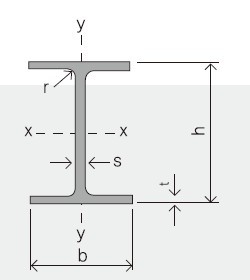
Section | Standard Sectional Dimensions(mm) | ||||
h | b | s | t | Mass Kg/m | |
IPE80 | 80 | 46 | 3.80 | 5.20 | 6.00 |
IPE100 | 100 | 55 | 4.10 | 5.70 | 8.10 |
IPE120 | 120 | 64 | 4.80 | 6.30 | 10.40 |
IPE140 | 140 | 73 | 4.70 | 6.90 | 12.90 |
IPE160 | 160 | 82 | 5.00 | 7.40 | 15.80 |
IPE180 | 180 | 91 | 5.30 | 8.00 | 18.80 |
IPE200 | 200 | 100 | 5.60 | 8.50 | 22.40 |
IPE220 | 220 | 110 | 5.90 | 9.20 | 26.20 |
IPE240 | 240 | 120 | 6.20 | 9.80 | 30.70 |
IPE270 | 270 | 135 | 6.60 | 10.20 | 36.10 |
IPEAA80 | 80 | 46 | 3.20 | 4.20 | 4.95 |
IPEAA100 | 100 | 55 | 3.60 | 4.50 | 6.72 |
IPEAA120 | 120 | 64 | 3.80 | 4.80 | 8.36 |
IPEAA140 | 140 | 73 | 3.80 | 5.20 | 10.05 |
IPEAA160 | 160 | 82 | 4.00 | 5.60 | 12.31 |
IPEAA180 | 180 | 91 | 4.30 | 6.50 | 15.40 |
IPEAA200 | 200 | 100 | 4.50 | 6.70 | 17.95 |
5.Color marking: There will be color marking on both end of the bundle for the cargo delivered by bulk vessel. That makes it easily to distinguish at the destination port.
Tag mark: there will be tag mark tied up on the bundles. The information usually including supplier logo and name, product name, made in China, shipping marks and other information request by the customer.
If loading by container the marking is not needed, but we will prepare it as customer request.
6. Shipment: In containers or in bulk cargo
FAQ:
Q1: Why buy Materials & Equipment from OKorder.com?
A1: All products are carefully selected from China's most reliable manufacturing enterprises. Through its ISO certifications, OKorder.com adheres to the highest standards and a commitment to supply chain safety and customer satisfaction. We can guarantee the quality!
Q2:What's your payment terms ?
A2: We can accept T/T,LC at sight and time LC.
Q3: Can you offer the third part inspection certificates ?
A3: Yes, we can apply third part inspection before shipping, such as SGS, BV, etc .
Images:
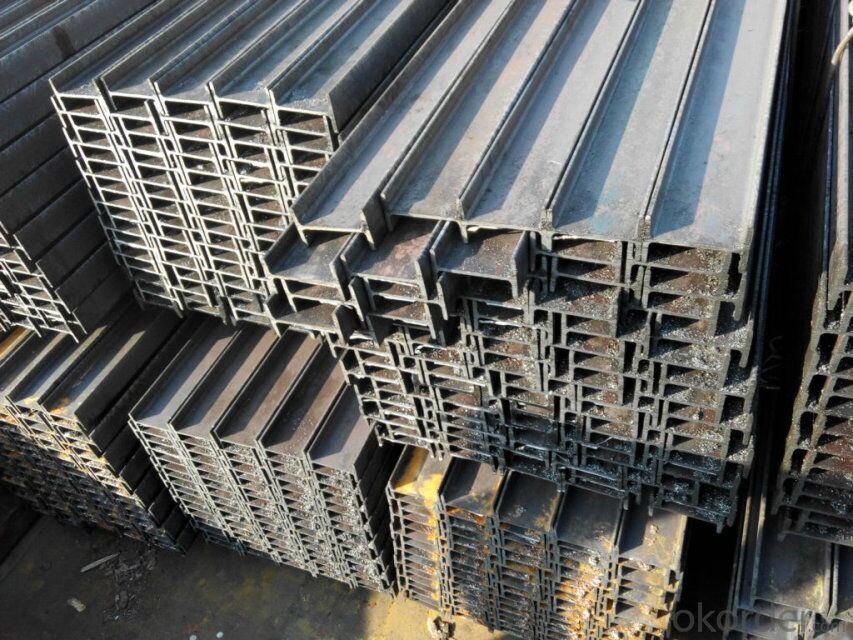
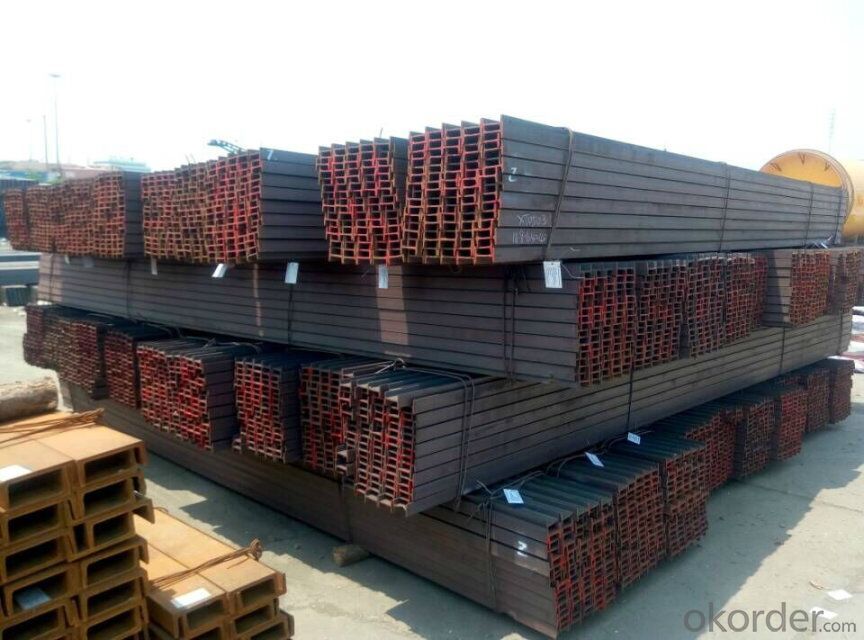
- Q: What are the typical costs associated with steel I-beams?
- The typical costs associated with steel I-beams can vary depending on several factors. Firstly, the size and weight of the beam will play a significant role in determining the cost. Larger and heavier I-beams will generally be more expensive than smaller ones. Another factor that can affect the cost is the grade of steel used. Different grades of steel have varying levels of strength and durability, and therefore, different price points. Higher-grade steel will typically be more costly than lower-grade options. Additionally, the length of the beam can impact the cost. Longer beams will require more material and may also require specialized transportation, which can increase the overall price. It is also important to consider the quantity needed. Ordering a larger quantity of steel I-beams may result in volume discounts, reducing the cost per unit. Furthermore, market conditions and the location of the supplier can influence the cost. Prices can vary regionally due to factors such as supply and demand, transportation costs, and local competition. To determine the exact costs associated with steel I-beams, it is recommended to contact suppliers or consult pricing guides specific to the steel industry.
- Q: Can steel I-beams be used in convention centers or exhibition halls?
- Convention centers and exhibition halls can definitely make use of steel I-beams. These beams are widely employed in the construction sector because of their robustness and capacity to bear heavy loads. With their exceptional structural support, they are perfectly suited for large, spacious areas like convention centers and exhibition halls. Steel I-beams are capable of handling substantial weights and are highly durable, making them essential for spaces that often host events with numerous attendees and require the ability to accommodate various equipment and displays. Moreover, the versatility of steel I-beams allows for easy customization and design to meet specific architectural requirements, providing flexibility in the layout and design of convention centers and exhibition halls. Consequently, these venues frequently rely on steel I-beams during construction to ensure both structural integrity and functionality.
- Q: Can Steel I-Beams be used for overhead cranes?
- Yes, Steel I-Beams can be used for overhead cranes. Steel I-Beams are commonly used as structural elements in the construction industry due to their strength and load-bearing capabilities. These beams are designed to provide support and stability in various applications, including overhead crane systems. Overhead cranes require durable and sturdy support structures to handle heavy loads and ensure safe operation. Steel I-Beams are ideal for this purpose, as they offer high strength-to-weight ratio and are capable of withstanding the dynamic forces exerted by the crane. The design and specifications of the Steel I-Beams for overhead cranes depend on factors such as the weight capacity of the crane, the span or length of the crane runway, and the type of load being lifted. The beams need to be properly sized and engineered to handle the specific requirements of the crane system. Additionally, Steel I-Beams can be easily connected and joined to create a strong and rigid framework for the crane system. They can also be integrated with other components such as trolleys, hoists, and bridge girders to form a complete overhead crane setup. It is important to ensure that the Steel I-Beams used for overhead cranes are of high quality and meet the necessary standards and codes for structural integrity and safety. Regular inspections and maintenance should also be conducted to ensure the continued reliability and performance of the crane system.
- Q: Does the surrounding rock of tunnel V first load I-beam or first lead bolt?
- In the individual construction, in order to ensure the external inclination of the small catheter, the drill is drilled at the waist of the I-beam, and the small catheter is passed through the waist of the I-beam, which greatly reduces the function of the i-beam. This method of construction is not allowed by the design. Therefore, the best solution should be to design and replace large numbers of I-beam and allow drilling in the middle of I-beam (after drilling, the I-beam can meet the requirements of design support).
- Q: How do steel I-beams perform in terms of seismic resistance?
- Steel I-beams possess exceptional seismic resistance due to their structural design, which enables them to endure the forces generated by earthquakes. The shape of I-beams provides a high strength-to-weight ratio, allowing them to support heavy loads while remaining flexible enough to absorb and dissipate seismic energy. Ductility is a key advantage of steel I-beams in terms of seismic resistance. Ductility refers to a material's capability to deform under stress without fracturing. When an earthquake occurs, the building vibrates due to the shaking ground. Steel I-beams can flex and bend without breaking, effectively absorbing seismic energy and preventing catastrophic failures. This ability to deform and absorb energy aids in distributing earthquake forces throughout the structure, minimizing localized damage. Moreover, enhancing the seismic resistance of steel I-beams is easily achievable through reinforcement and retrofitting. By incorporating additional bracing, cross-members, or steel plates, the overall stiffness and strength of the I-beams can be augmented, thereby enhancing their performance during earthquakes. Furthermore, steel is a homogeneous material with consistent properties, enabling accurate engineering calculations and predictable behavior under seismic loads. This predictability empowers engineers to design structures that meet the necessary safety standards for seismic resistance. In conclusion, steel I-beams are widely acclaimed for their outstanding seismic resistance. Their robustness and flexibility, coupled with the ability to reinforce and retrofit them, make them the preferred choice for earthquake-prone areas, ensuring the safety and stability of buildings during seismic events.
- Q: What's the difference between 16# I-beam and 16A I-beam?
- No. 16, said waist high waist thickness 16cm, if have different sizes, need to add a, B, C difference, but the standard table didn't see this type of 16a, more than 20 have a, B or C type difference.
- Q: How does the arch concrete of the tunnel be poured up? How can the support be used before the casting? Is it made of I-beam? Is it directly supported by earthwork?
- The excavation of the tunnel face, slag, to the primary support system, first hit the bolt, then use steel or steel made of steel, installation support in tunnel contour, and then sprayed concrete (poor surrounding rock hanging steel mesh, then sprayed fiber concrete).
- Q: Can steel I-beams be used for sign structures?
- Yes, steel I-beams can be used for sign structures. Steel I-beams are commonly used in construction due to their strength and durability. They can support heavy loads and provide stability, making them suitable for supporting sign structures. The use of steel I-beams ensures that the sign structure can withstand environmental factors such as wind, ensuring its longevity. Additionally, steel I-beams can be fabricated to the desired shape and size, allowing for flexibility in design and customization. Overall, steel I-beams are a reliable and commonly used material for sign structures due to their strength and versatility.
- Q: What are the different fabrication methods for steel I-beams?
- Steel I-beams can be fabricated using various methods, each with its own benefits and applications. 1. The most commonly employed technique is hot rolling. This involves heating a sizable steel billet above its recrystallization temperature and then passing it through a series of rollers to shape it into the desired I-beam profile. Hot rolling ensures excellent structural integrity and consistent dimensions and mechanical properties. 2. Another method involves welding or assembling individual steel plates or sections to create the I-beam shape. This approach is often used for specialized or custom applications where the dimensions or properties of the I-beam need to be tailored. Welding can be accomplished using various techniques, such as submerged arc welding or gas metal arc welding, depending on the specific requirements. 3. Cold rolling is another technique utilized to shape steel strips or plates into the I-beam profile. Unlike hot rolling, this process is carried out at room temperature. Cold rolling is typically employed for smaller-sized I-beams or applications where precise dimensions and surface finish are crucial. It is also commonly used for stainless steel I-beams. 4. Extrusion is a process that can create intricate cross-sectional shapes with a continuous length. For steel I-beams, a heated billet is forced through a die to form the desired I-beam shape. Extrusion is frequently utilized to manufacture lightweight or specialized I-beams with unique profiles. Each fabrication method has distinct advantages and considerations, such as cost, production speed, size limitations, and the ability to meet specific design requirements. The choice of fabrication method depends on factors such as the desired I-beam size, properties, and application.
- Q: What are the different aesthetic options available for steel I-beams?
- There are several aesthetic options available for steel I-beams to enhance their visual appeal and integrate them seamlessly into architectural designs. Some of the popular aesthetic options include: 1. Powder Coating: Steel I-beams can be powder coated with a wide range of colors and finishes, allowing them to match or complement the surrounding environment or architectural elements. This process not only adds a layer of protection against corrosion but also provides a durable and attractive finish. 2. Galvanization: Galvanizing steel I-beams involves applying a layer of zinc coating to protect against rust and corrosion. This option gives the beams a distinctive silver-gray appearance, which can add an industrial or contemporary aesthetic to the overall design. 3. Polishing: Polishing steel I-beams creates a smooth and reflective surface, giving them a sleek and modern look. This option is often used in contemporary architectural designs where a high-end, luxurious feel is desired. 4. Brushed Finish: A brushed finish involves creating a pattern of fine lines on the surface of the steel I-beam. This option can provide a unique texture and a more tactile experience, making it a popular choice for designs that aim to incorporate an element of artistic expression. 5. Custom Paint or Coating: Steel I-beams can also be customized with specific paint colors or coatings to match the desired aesthetic. This option allows for creativity and personalization, making it an excellent choice for projects that require a specific color scheme or branding. It's important to note that the choice of aesthetic options for steel I-beams may vary depending on the manufacturer, project requirements, and budget constraints. Consulting with professionals such as architects, engineers, or steel fabricators can provide valuable insights and recommendations on the best aesthetic options available for steel I-beams in a particular project.
Send your message to us
Hot Rolled Steel I-Beams with best price
- Loading Port:
- Tianjin
- Payment Terms:
- TT OR LC
- Min Order Qty:
- 25 m.t
- Supply Capability:
- 10000 m.t/month
OKorder Service Pledge
OKorder Financial Service
Similar products
Hot products
Hot Searches
Related keywords
